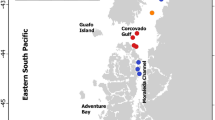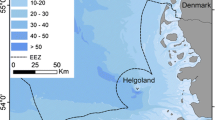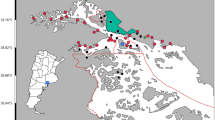Abstract
Fisheries-related mortality has been influential in driving global declines in seabird populations. Understanding the overlap between seabird distribution and fisheries is one important element in assessing bycatch risk, and may be achieved by tracking the movements of individual birds and fishing vessels. Here, we assess the spatiotemporal overlap between the vulnerable Campbell Albatross Thalassarche impavida and large (>28 m) commercial fishing boats in New Zealand’s Exclusive Economic Zone (EEZ). We used a novel analytical approach, bivariate Gaussian bridge movement modelling, to compute spatiotemporal utilization distributions of bird-borne global positioning system (GPS) loggers and data from the Vessel Monitoring System. We tracked birds for 28,815 h during incubation and chick brooding, with half of this time spent within New Zealand’s EEZ, utilizing 6.7% of the available area. However, there was no evidence that albatrosses and fishing vessels were in the same location simultaneously. We accounted for the broader ecological footprint of fishing vessels by calculating the distance between GPS-fix locations for albatrosses and fishing vessels, revealing that albatrosses were within 30 km of fishing vessels in 8.4% of foraging trips. This highlights differences in estimated fine-scale spatiotemporal overlaps which may be due to the distance between albatrosses and vessels or the methods used. Overall, the low levels of spatial overlap could be a result of Campbell Albatross’ preference for foraging in areas without fishing activity or competitive exclusion by other species. Our results reinforce the importance of multi-scale, temporally explicit, and multi-national approaches to risk assessment, as Campbell Albatrosses spend approximately half of their time foraging outside New Zealand’s EEZ.
Zusammenfassung
Besenderung zeigt limitierte Interaktionen zwischen Campbell Albatrossen und der Fischerei während der Brutzeit
Die durch Fischfang verursachte Sterblichkeit hat einen entscheidenden Einfluss auf die globalen Rückgänge von Seevogelpopulationen. Ein wichtiges Element zur Abschätzung des Beifangrisikos ist das Verständnis der Überschneidung von Seevogelverbreitungen und Fischerei. Ein solches Verständnis kann erlangt werden durch die Verfolgung der Bewegungen einzelner Seevogelindividuen und der von Fischereibooten. In der vorliegenden Studie untersuchen wir die räumlich-zeitliche Überschneidung zwischen dem gefährdeten Campbell Albatross Thalassarche impavida und großen (> 28 m) kommerziellen Fischereischiffen in der neuseeländischen Ausschließlichen Wirtschaftszone (AWZ) ab. Dazu nutzten wir einen neuen Analyseansatz, „Bivariate Gaussian Bridge Movement“-Modelle, um aus den GPS-Loggerdaten der Vögel und Daten des Schiffsmonitorings die räumlich-zeitliche Nutzungsverteilung zu berechnen. Wir verfolgten besenderte Vögel über 28.815 Stunden während der Inkubations- und Huderphase. Die Hälfte dieser Zeit verbrachten die Vögel in der neuseeländischen AWZ, wobei sie 6,7% der insgesamt verfügbaren Fläche nutzten. Jedoch gab es keine Belege dafür, dass sich Albatrosse und Fischereiboote gleichzeitig im selben Gebiet aufhielten. Wir berücksichtigten auch den breiteren ökologischen Fußabdruck der Fischerei durch die Berechnung der Distanz zwischen den GPS-Punkten der Albatrosse und den Fischereibooten. Es zeigte sich, dass sich die Albatrosse in 8,4% ihrer Nahrungsflüge in einem 30 km Radius um die Fischereiboote aufhielten. Dies zeigt die Unterschiede zwischen den berechneten feinskaligen räumlich-zeitlichen Überschneidungen auf, die wahrscheinlich auf die Distanzen zwischen Albatrossen und Schiffen oder auf die angewendeten Methoden zurückzuführen sind. Die geringe räumliche Überschneidung kann die Folge davon sein, dass die Albatrosse Nahrungsgebiete präferieren, in denen nicht gefischt wird, oder von Konkurrenzausschluss durch andere Arten. Unsere Ergebnisse bekräftigen die Wichtigkeit mehrskaliger, zeitlich expliziter und multinationaler Ansätze der Gefährdungsabschätzung, da Campbell Albatrosse schätzungsweise die Hälfte der Zeit zur Nahrungssuche außerhalb der neuseeländischen AWZ verbringen.

Similar content being viewed by others
References
Abraham ER, Thompson FN (2012) Captures of birds in trawl fisheries, in the New Zealand Exclusive Economic Zone, during the 2010–11 fishing-year. http://data.dragonfly.co.nz/psc/v20121101/explore/. Accessed 15 Apr 2013
Abraham ER, Thompson FN (2015) Captures of all birds in trawl fisheries, in the New Zealand Exclusive Economic Zone, during the 2013–14 fishing year. https://data.dragonfly.co.nz/psc/v20150002/birds/trawl/all-vessels/eez/2013-14/. Accessed 20 Jan 2017
Abraham ER, Pierre JP, Middleton DA et al (2009) Effectiveness of fish waste management strategies in reducing seabird attendance at a trawl vessel. Fish Res 95:210–219
Anderson O, Small C, Croxall J et al (2011) Global seabird bycatch in longline fisheries. Endanger Species Res 14:91–106. doi:10.3354/esr00347
Bartle JA (1991) Incidental capture of seabirds in the New Zealand subantarctic squid trawl fishery, 1990. Bird Conserv Int 1:351–359
Bodey TW, Jessopp MJ, Votier SC et al (2014) Seabird movement reveals the ecological footprint of fishing vessels. Curr Biol 24:R514–R515
Brothers N (1991) Albatross mortality and associated bait loss in the Japanese longline fishery in the Southern Ocean. Biol Conserv 55:255–268
Bugoni L, D’Alba L, Furness RW (2009) Marine habitat use of wintering Spectacled Petrels Procellaria conspicillata, and overlap with longline fishery. Mar Ecol Prog Ser 374:273–285
Catry P, Lemos RT, Brickle P et al (2013) Predicting the distribution of a threatened albatross: the importance of competition, fisheries and annual variability. Prog Oceanogr 110:1–10
Cherel Y, Waugh S, Hanchet S (1999) Albatross predation of juvenile Southern Blue Whiting (Micromesistius australis) on the Campbell Plateau. NZ J Mar Freshw Res 33:437–441
Collet J, Patrick SC, Weimerskirch H (2015) Albatrosses redirect flight towards vessels at the limit of their visual range. Mar Ecol Prog Ser 526:199–205
Croxall JP, Gales R (1998) An assessment of the conservation status of albatrosses. In: Robertson G, Gales R (eds) Albatross biology and conservation. Surrey Beatty and Sons, Chipping Norton, pp 46–65
Croxall J, Small C, Sullivan B et al (2013) Appropriate scales and data to manage seabird–fishery interactions: comment on Torres et al. (2013). Mar Ecol Prog Ser 493:297–300
Dietrich KS, Melvin EF, Conquest L (2008) Integrated weight longlines with paired streamer lines—best practice to prevent seabird bycatch in demersal longline fisheries. Biol Conserv 141:1793–1805. doi:10.1016/j.biocon.2008.04.023
Duncan S, Stewart TI, Oliver M et al (2013) Portable global positioning system receivers: static validity and environmental conditions. Am J Prev Med 44:e19–e29
Favero M, Blanco G, García G et al (2011) Seabird mortality associated with ice trawlers in the Patagonian shelf: effect of discards on the occurrence of interactions with fishing gear. Anim Conserv 14:131–139. doi:10.1111/j.1469-1795.2010.00405.x
Gales R, Brothers N, Reid T (1998) Seabird mortality in the Japanese tuna longline fishery around Australia, 1988–1995. Biol Conserv 86:37–56
Granadeiro JP, Phillips RA, Brickle P, Catry P (2011) Albatrosses following fishing vessels: how badly hooked are they on an easy meal? PLoS One 6:e17467. doi:10.1371/journal.pone.0017467
Gurarie E, Andrews RD, Laidre KL (2009) A novel method for identifying behavioural changes in animal movement data. Ecol Lett 12:395–408
Hobday AJ, Hartog JR, Timmiss T, Fielding J (2010) Dynamic spatial zoning to manage Southern Bluefin Tuna (Thunnus maccoyii) capture in a multi-species longline fishery. Fish Oceanogr 19:243–253
Hobday AJ, Maxwell SM, Forgie J et al (2014) Dynamic ocean management: integrating scientific and technological capacity with law, policy and management. Stanf Environ Law J 33:125–165
Howell EA, Kobayashi DR, Parker DM et al (2008) TurtleWatch: a tool to aid in the bycatch reduction of Loggerhead Turtles Caretta caretta in the Hawaii-based pelagic longline fishery. Endanger Species Res 5:267–278
IUCN (2016) The IUCN Red List of Threatened Species. Version 2016-3
Jiménez S, Domingo A, Brazeiro A (2009) Seabird bycatch in the Southwest Atlantic: interaction with the Uruguayan pelagic longline fishery. Polar Biol 32:187–196
Karpouzi VS, Watson R, Pauly D (2007) Modelling and mapping resource overlap between seabirds and fisheries on a global scale: a preliminary assessment. Mar Ecol Prog Ser 343:87–99
Kranstauber B, Kays R, LaPoint SD et al (2012) A dynamic Brownian bridge movement model to estimate utilization distributions for heterogeneous animal movement. J Anim Ecol 81:738–746
Kranstauber B, Safi K, Bartumeus F (2014) Bivariate Gaussian bridges: directional factorization of diffusion in Brownian bridge models. Mov Ecol 2:5
Lewison RL, Crowder LB (2003) Estimating fishery bycatch and effects on a vulnerable seabird population. Ecol Appl 13:743–753
Løkkeborg S (2003) Review and evaluation of three mitigation measures—bird-scaring line, underwater setting and line shooter—to reduce seabird bycatch in the north Atlantic longline fishery. Fish Res 60:11–16
Ministry for Primary Industries (2014) Aquatic environment and biodiversity annual review 2014. Compiled by the Fisheries Management Science Team. Ministry for Primary Industries, Wellington
Moore PJ (2004) Abundance and population trends of mollymawks on Campbell Island. Science for Conservation 242, Department of Conservation, Wellington
Murray TE, Bartle JA, Kalish SR, Taylor PR (1993) Incidental capture of seabirds by Japanese Southern Bluefin Tuna longline vessels in New Zealand waters, 1988–1992. Bird Conserv Int 3:181–210
Nel DC, Ryan PG, Watkins BP (2002) Seabird mortality in the Patagonian toothfish longline fishery around the Prince Edward Islands, 1996–2000. Antarct Sci 14:151–161. doi:10.1017/S0954102002000718
Niwa P (1999) Exploitation of the marine environment by two sympatric Albatrosses in the Pacific Southern Ocean. Mar Ecol Prog Ser 117:243–254
Patrick SC, Bearhop S, Bodey TW, Grecian WJ, Hamer KC, Lee J, Votier SC (2015) Individual seabirds show consistent foraging strategies in response to predictable fisheries discards. J Avian Biol 46:431–440
Phillips RA, Silk JR, Croxall JP, Afanasyev V (2006) Year-round distribution of White-chinned Petrels from South Georgia: relationships with oceanography and fisheries. Biol Conserv 129:336–347
Pierre JP, Abraham ER, Middleton DA et al (2010) Reducing interactions between seabirds and trawl fisheries: responses to foraging patches provided by fish waste batches. Biol Conserv 143:2779–2788
Robertson CJR, Nunn GB (1998) Towards a new taxonomy for albatrosses. Albatross Biol Conserv Surrey Beatty Sons Chipping Nort Aust 23:13–19
Rolland V, Weimerskirch H, Barbraud C (2010) Relative influence of fisheries and climate on the demography of four albatross species. Glob Change Biol 16:1910–1922. doi:10.1111/j.1365-2486.2009.02070.x
Sagar PM (2014) Population estimates and trends of Campbell and Grey-headed Albatrosses at Campbell Island. National Institute of Water & Atmospheric Research Ltd, Christchurch, New Zealand. http://www.doc.govt.nz/Documents/conservation/marine-and-coastal/marine-conservationservices/reports/pop2012-04-campbell-and-grey-headed-albatross-population-estimates.pdf
Sangster G, Collinson JM, Crochet P-A et al (2013) Taxonomic recommendations for Western Palearctic birds: ninth report. Ibis 155:898–907
Sullivan BJ, Reid TA, Bugoni L (2006) Seabird mortality on factory trawlers in the Falkland Islands and beyond. Biol Conserv 131:495–504
Sztukowski LA (2016) Foraging ecology of the Campbell Albatross: individual specialisation and fisheries interactions. Dissertation, Plymouth University
Torres L, Thompson D, Bearhop S et al (2011) White-capped Albatrosses alter fine-scale foraging behavior patterns when associated with fishing vessels. Mar Ecol Prog Ser 428:289–301. doi:10.3354/meps09068
Torres LG, Sagar PM, Thompson DR, Phillips RA (2013a) Scaling down the analysis of seabird–fishery interactions. Mar Ecol Prog Ser 473:275–289
Torres LG, Sagar PM, Thompson DR, Phillips RA (2013b) Scale-dependence of seabird–fishery data analysis and management: reply to Croxall et al. (2013). Mar Ecol Prog Ser 493:301–304
Tuck GN, Thomson RB, Barbraud C et al (2015) An integrated assessment model of seabird population dynamics: can individual heterogeneity in susceptibility to fishing explain abundance trends in Crozet Wandering Albatross? J Appl Ecol 52:950–959
Votier SC, Bearhop S, Fyfe R, Furness RW (2008) Temporal and spatial variation in the diet of a marine top predator—links with commercial fisheries. Mar Ecol Prog Ser 367:223–232
Votier SC, Bearhop S, Witt MJ et al (2010) Individual responses of seabirds to commercial fisheries revealed using GPS tracking, stable isotopes and vessel monitoring systems. J Appl Ecol 47:487–497
Votier SC, Bicknell A, Cox SL et al (2013) A bird’s eye view of discard reforms: bird-borne cameras reveal seabird/fishery interactions. PLoS One 8:e57376
Waugh SM, Weimerskirch H, Moore PJ, Sagar PM (1999) Population dynamics of Black-browed and Grey-headed Albatrosses Diomedea melanophrys and D. chrysostoma at Campbell Island, New Zealand, 1942–96. Ibis 141:216–225
Weimerskirch H, Le Corre M, Bost CA et al (2008) Foraging strategy of Masked Boobies from the largest colony in the world: relationship to environmental conditions and fisheries. Mar Ecol Prog Ser 362:291–302
Acknowledgements
We would like to thank the Campbell Island field crews, boat crews (particularly the RV Tiama), and the Department of Conservation personnel, who made the data collection possible. Special thanks to Caitlin Kroeger for field assistance, her company and project discussions. Thanks also to Samantha Patrick, Nils Piechaud, Grant Humphries, Emilie Hall, Holly Armstrong, Clare Embling, Samantha Cox, and Andy Foggo for geographic information system (GIS) assistance, thoughtful discussions, and comments on drafts. We are grateful to the New Zealand Ministry of Fisheries for providing access to the VMS data. This study was funded through a MARES grant (FPA 2011-0016), the National Institute of Water and Atmospheric Research Limited, the New Zealand Department of Conservation and the New Zealand Ministry of Business, Innovation and Employment. Maps were created using ArcGIS software (Ocean Basemap Sources—Esri, GEBCO, NOAA, National Geographic, De Lorme, HERE, Geonames.org, and other contributors) by Esri. ArcGIS and ArcMap are the intellectual property of Esri and are used herein under license.
Author information
Authors and Affiliations
Corresponding author
Ethics declarations
Conflict of interest
The authors declare that they have no conflict of interest. All applicable international, national, and/or institutional guidelines for the care and use of animals were followed. All scientific procedures and site access were conducted under permit issued by the New Zealand Department of Conservation and were approved by the Animal Ethics Committee at Plymouth University. Great care was taken to minimize stress to the animals during handling.
Additional information
Communicated by C. Barbraud.
Electronic supplementary material
Below is the link to the electronic supplementary material.
Rights and permissions
About this article
Cite this article
Sztukowski, L.A., van Toor, M.L., Weimerskirch, H. et al. Tracking reveals limited interactions between Campbell Albatross and fisheries during the breeding season. J Ornithol 158, 725–735 (2017). https://doi.org/10.1007/s10336-016-1425-4
Received:
Revised:
Accepted:
Published:
Issue Date:
DOI: https://doi.org/10.1007/s10336-016-1425-4




